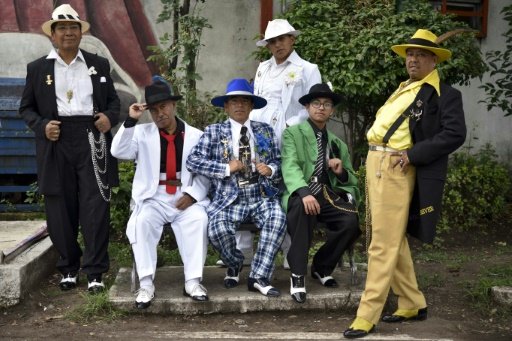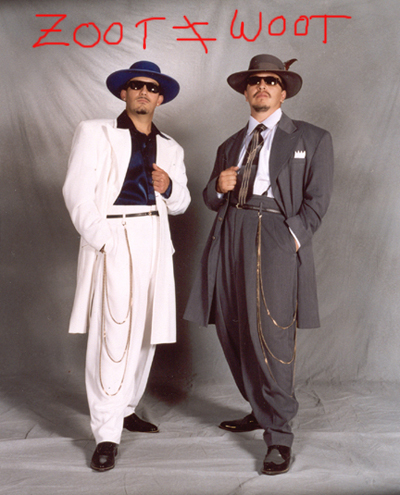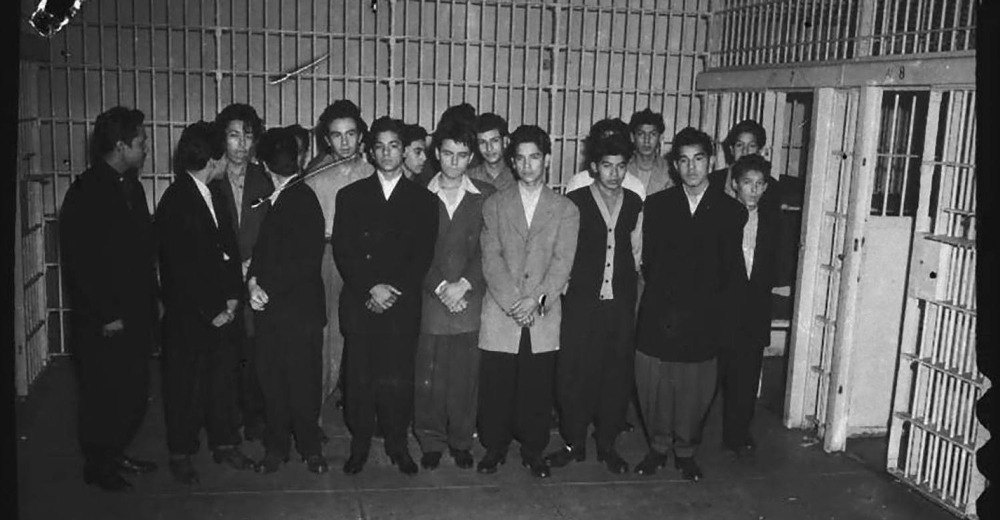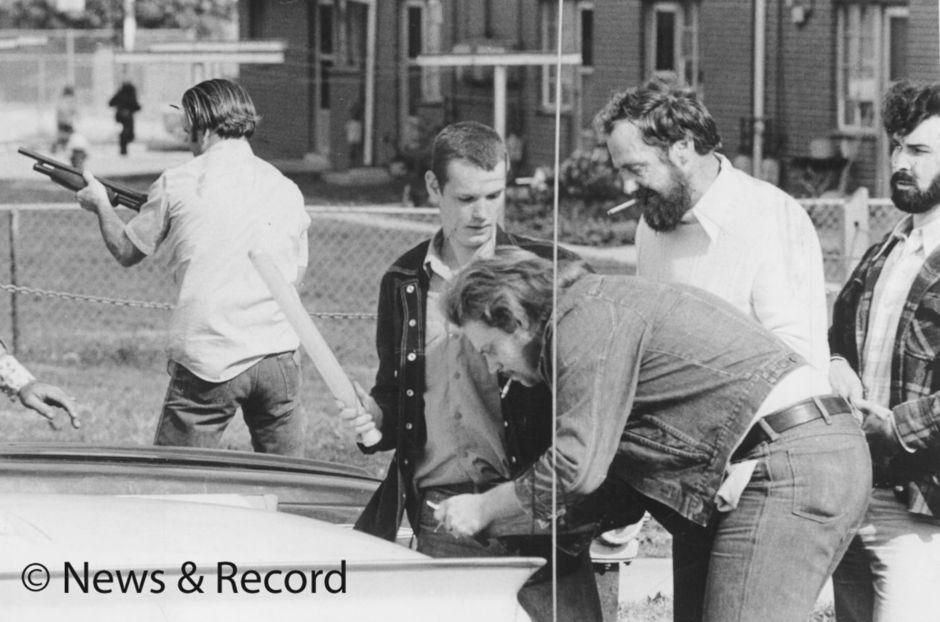Judi Lynn
Judi Lynn's JournalMexicos pachucos keep zoot suits, defiance alive
Mexico’s ‘pachucos’ keep zoot suits, defiance alive
BY AGENCE FRANCE PRESSE · AUGUST 31ST, 2017 (10 HOURS AGO)

Decked out in baggy suits, their watch chains swinging to the mambo as feathers bop atop their wide-brimmed hats, Mexico’s “pachucos” are keeping alive the tradition of the zoot suit — and the defiance it represents.
Born in Mexican immigrant communities in the United States in the 1930s, pachuco culture started out as the gangsta style of its time — complete with criminal associations, baggy pants and bling.
It was a time of deep prejudice in the American south and west, where restaurants often posted signs reading “No dogs, negroes or Mexicans.”
In a show of defiance of the dominant white culture, young Mexicans joined urban blacks in sporting the zoot suit — long jackets, baggy pants tapering to a peg at the ankles, Oxford shoes, dangling watch fobs and splaying hats.
More:
http://www.capitalfm.co.ke/lifestyle/2017/08/31/mexicos-pachucos-keep-zoot-suits-defiance-alive/
Editorials and other articles:
https://www.democraticunderground.com/1016192396






~ ~ ~
Combing the Zoot Suit Riots and the Murder At Sleepy Lagoon
By Brandon Diaz
March 09, 2016
Combing the Zoot Suit Riots and the Murder At Sleepy LagoonBy Brandon Diaz
March 09, 2016
It was 1940s Los Angeles. Orange groves hung strings of citrus just miles to the south. Houses were popping up in the San Fernando Valley to the east. A jaunt to the Pacific lay just a few miles west. Young couples swooned over one-another, necking on those beaches, sipping bottled Cokes and puffing Lucky Strikes under blistering Southern Cali suns.
Los Angeles was in a boom.
Its greater metro area had a population larger than that of 37 states. Some 2.8 million Angelenos planted their flags and seeded their roots. There were Japanese, Chinese, Filipinos, Armenians, Italians, Blacks, and Mexican-Americans weaving into the sprawl, all amongst one another. The depression was over, and industries offered jobs, good-paying jobs. The stability felt tactile. Some sense of the promise of America being delivered. Actual prosperity a few turns of a wrench away.
But with cultural richness blossoming, one specific tragedy would pour floodlights over over the city, illuminating a bigoted mirk that crawled the social undercurrent of 1940s LA:

More:
https://thehundreds.com/blogs/content/combing-the-zoot-suit-riots-and-the-murder-at-sleepy-lagoon
WHY THESE MEXICAN WRITERS ARE DITCHING SPANISH FOR INDIGENOUS LANGUAGES
WHY THESE MEXICAN WRITERS ARE DITCHING SPANISH FOR INDIGENOUS LANGUAGES
By Theo Ellin Ballew
THE DAILY DOSE
AUG 14 2017
It was standing room only in the Los Angeles Central Library last July. The crowd of some 300 ranged from multigenerational Mexican immigrant families to young Californians of indigenous Mexican extraction to academics, some of whom had traveled across the country for the event. The participants enjoyed readings of poetry and short stories and a rap performance by Pat Boy. And yet none of the material was in Spanish — it was in Zapotec, Tzotzil, Mayan and other languages spoken long before Europeans washed up on the shores of what is now Mexico.
Octavio Paz, Juan Rulfo, Rosario Castellanos, Carlos Fuentes … Mexico’s Spanish-language literature is one of the richest in Latin America. But for hundreds of years, the literature written in languages that existed before European colonization were all but silenced on the global scene — even though they were well-recognized by many Mexicans. Now, interest in this writing is surging worldwide. And it has its own rich history: In some traditions of pre-Columbian Mexico, when an estimated 130 languages were spoken, books were bound in deerskin, students were obliged to memorize poems and songs, and a misused or forgotten word was considered a cause of illness or death.
This increase in global interest can be seen in the surge in translations. Sales figures and other data are difficult to come by, but book lovers in New York can find English or Spanish versions of contemporary literature written in Mazatec, which is still spoken by 220,000 people, mainly in northern Oaxaca. In Berlin, you can find German translations of works written in Purépecha, aka Tarascan, which is spoken by some 125,000 people in the highlands of Michoacán.
According to Janet Martínez of the Frente Indígena de Organizaciones Binacionales, who organized the conference in Los Angeles, international publishers have yet to realize the potential size of this growing market. David Shook agrees. A translator and co-founder of Phoneme Media, a nonprofit in Los Angeles that is the foremost publisher of Mexican indigenous language literature in the U.S., Shook was shocked when he sold all 750 copies of the first edition of Like a New Sun, an anthology of contemporary poetry published in 2015 and originally written in Huasteca, Nahuatl, Zoque and other languages. Natalia Toledo’s collection, The Black Flower and Other Zapotec Poems, sold at least that many copies, Shook says, and was shortlisted for the 2016 National Translation Award.

More:
http://www.ozy.com/fast-forward/why-these-mexican-writers-are-ditching-spanish-for-indigenous-languages/75743
A Stunning Display of Wildflowers Just Bloomed in One of the Driest Places on Earth
A Stunning Display of Wildflowers Just Bloomed in One of the Driest Places on Earth
An "intense and unexpected rain" transformed Chile's Atacama Desert.

by LYNDSEY MATTHEWS
AUG 30, 2017
Beyond the North and South Poles, Chile's Atacama Desert is the driest place on Earth. In any given year, this plateau in northern Chile only gets about 0.6 inches of rain, while some areas get as little as 0.04 inches.
Most of the time it looks like this—dry and arid.

But after an "intense and unexpected rain," the desert floor erupted with a massive wildflower bloom that's drawing visitors from all over Chile and even farther away to come see the phenomenon that's known as "desierto florido" (flowering desert), the BBC reports.
More:
http://www.townandcountrymag.com/leisure/travel-guide/a12141685/atacama-desert-wildflower-bloom/
Environment & Energy:
https://www.democraticunderground.com/1127112577
Statues of medical racist who experimented on slaves should also be taken down
MONDAY, AUG 28, 2017 08:04 PM CDT
Enslaved women with incurable diseases had surgery performed on them and weren't given any anaesthesia
STEPHEN KENNY, THE CONVERSATION
Confederate generals are not the only statues causing public outrage in the US. On Saturday, protesters gathered in New York City’s Central Park to call for the removal of a monument to James Marion Sims — the “father of gynaecology” — a doctor who bought, sold and experimented on slaves.
There are two other Sims statues on state-owned property. One is in Columbia, South Carolina, and the other in Montgomery, Alabama. In an interview with MSNBC, Steve Benjamin, the mayor of Columbia, recently agreed that the local Sims statue should come down “at some point”. Now the New York Academy of Medicine has reissued a statement supporting the removal of Sims’ effigy from Central Park.
Over the past five decades, a small army of academics — including social historians, feminists, African American scholars and bioethicists — have reached a consensus that Sims’ medical research on enslaved patients was dangerous, exploitative and deeply unethical — even by the standards of his times. And doctors at the Medical University of South Carolina, in Sims’ home state, have publicly acknowledged Sims’ overt medical racism.
The ongoing removal of statues that celebrate the Confederacy and other forms of white supremacy, is an opportunity to also correct the problem of Sims’ troubling presence on the symbolic landscape of America’s past.
More:
http://www.salon.com/2017/08/28/statues-of-medical-racist-who-experimented-on-slaves-should-also-be-taken-down_partner/



~ ~ ~
Council Speaker Urged to Remove Statue of Doctor Who Experimented on Slaves
By Jeff Mays | May 7, 2014 7:00am
@JeffCMays
. . .
However, Sims did not use anesthesia on the slave women he used as test subjects, operating on one woman at least 30 times. When Sims operated on white women using the techniques he had practiced on the slaves, those women were anesthetized.
Some have explained Sims' actions by citing the medical ethics of his times.
But Harriet Washington, author of "Medical Apartheid: The Dark History of Medical Experimentation on Black Americans from Colonial Times to the Present," and the winner of the 2007 National Book Critics Circle Award for nonfiction, said her research revealed that medical mores of the time did require consent, and that some of Sims' contemporaries objected to his methods.
"He perfected the technique that helped millions of women, but not these women," Washington said.
Parks Department officials said they have no intention to remove the bronze and granite statue, which was dedicated in 1894, and instead are in the process of finalizing language they hope will present a historically accurate picture of Sims, acknowledging three of his known slave subjects.
More:
https://www.dnainfo.com/new-york/20140507/east-harlem/council-speaker-urged-remove-statue-of-doctor-who-operated-on-slaves
Its personal: Uribe bashes UN anti-corruption chief in Guatemala
written by Adriaan Alsema August 28, 2017
Colombia’s former President Alvaro Uribe has not forgotten how now-UN commissioner Ivan Velasquez revealed the far-reaching ties between his family and paramilitary death squads.
When Velasquez worked for Colombia’s Supreme Court, he secured the arrest of Uribe’s cousin Mario, a former Senate president, who subsequently was imprisoned for using death squads to coerce voters to elect the Uribe heir into Congress.
The investigation against Uribe’s cousin was just one of many: Velasquez’ team revealed how many dozens of congressmen and governors, almost all belonging to the coalition that supported Uribe, had received support for the drug trafficking AUC paramilitary umbrella organization.
Between 2008 and 2010, the Uribe administration broke every necessary law to prevent the practice of “parapolitics” to come to light, a move that only led to the imprisonment of more Uribe allies.
More:
https://colombiareports.com/personal-uribe-bashes-un-anti-corruption-chief-guatemala/
As so many people know, some Miami "exiles" go back to Cuba.
That became known by anyone sober who watched tv news when Elian Gonzalez was held prisoner by the gusano community in Miami, and it was reported by national media that his great uncle Lazaro had met Elian twice before, when he was even younger, during two trips he made to Cuba on vacation. He was reported as having spent his days fishing, and his evenings in the hotel bars, and slept in Juan Miguel's own bedroom, while Juan Miguel slept outside in his car, to accommodate his father's brother. Very nice gesture, and Lazaro felt obligated to repay his generosity once, by buying him a goat. That's right, a goat.
So if "exiles" are so terrified of "commie" Cuba, why do they go back there? Aren't they afraid of being flung into prison and beaten until they squeak? A lot of US Americans have wondered about that once they heard about it.
Other Cubans do it, including the couple which survived the ordeal with Elian, which took the lives of the others on board, one of whom was Elian's mother Elisabet's boyfriend, an ex-con from Cuba who had killed a man in a fight, also named "Lazaro." He was unable to get a visa from the US Interests Section in Havana due to his violent record, but had made the crossing multiple times, staying with relatives in Miami, before deciding to go back, get Elisabet, her kid, and some paying customers and heading back to Miami.
From a book written by Anne Louise Bardach, a former journalist with the New York Times, who did a major series of articles on an interview with Luis Posada Carriles, one of the two masterminds of the Cubana airliner mid-air bombing which murdered well over 70 people, including children in a Cuban fencing team;
But there has been a slow but steady shift in the last decade-a nod to the clear majority of Cubans en exilio and on the island who crave family reunification. Since 1978, more than one million airline tickets have been sold for flights from Miami to Havana. Faced with the brisk and continuous traffic between Miami and Havana, hard-liners on both sides have opted to deny the new reality. Anomalies such as the phenomenon of reverse balseros, Cubans who, unable to adapt to the pressures and bustle of entrepreneurial Miami, return to the island, or gusañeros, expatriots who send a portion of their earnings home in exchange for unfettered travel back and forth to Cuba (the term is a curious Cuban hybrid of gusano and compañero, or comrade), are unacknowledged by both sides, as are those who live in semi-exilio, returning home to Cuba for long holidays.
Page XVIII
Preface
Cuba Confidential
Love and Vengeance
In Miami and Havana
Copyright© 2002 by
Ann Louise Bardach
https://www.democraticunderground.com/discuss/duboard.php?az=view_all&address=102x3023618#3024362
Don't forget Eloy Gutierrez Menoyo, who drove a lot of Miami gusanos wild when he decided, on a vacation with his wife and family to Cuba, to NOT return to the United States with them. He was even threatened by the U.S. Government once it was known he was staying there, which was a very conspicuous move by the George W Bush administration.
From an earlier link:
Posted February 09, 2005
Anthony Boadle | Reuters
A U.S. resident who had spent 22 years in a Cuban prison for opposing communism and returned to the island to work for democracy now faces a U.S. jail threat for violating travel restrictions.
Eloy Gutierrez Menoyo, a Cuban exile who returned in 2003, has been warned by the U.S. Treasury Department that he could be fined $250,000 or sent to prison for 10 years for staying in Cuba in violation of sanctions intended to isolate the government of Fidel Castro.
“They don’t understand: I am not a tourist in Cuba, I am an activist working to establish a legal space for an independent opposition,” Gutierrez Menoyo said on Tuesday in an interview.
“It is illogical. I’m here seeking freedom and the United States comes and tells me I face a 10-year prison sentence,” he complained.
More:
http://havanajournal.com/politics/entry/eloy_gutierrez_menoyo_threatened_by_us_for_living_in_cuba/
https://www.democraticunderground.com/110836176#post6
More on Eloy Gtierrez Menoyo, posted by tremendous, knowledgeable source DU'er, Mika, who has lived and worked in Cuba, made many trips back and forth, has family and friends there still, of course:
Response to Reply #49
52. Gutierrez Menoyo now lives in Cuba. After his move back to Cuba, the US won't let him visit the US.
Edited on Sun Dec-03-06 08:34 PM by Mika
According to the new BushCrimeInc dictate Mr. Gutierrez Menoyo has violated the rules regarding his length of stay in Cuba. He has reclaimed his right to live in Cuba as he is a Cuban citizen who never sought asylum in the US. In doing so he now is refused a US visa to visit his family in Miami, or do any speaking engagements in the US.
He has formed a new political party, Cambio Cubano/Cuban Change, (contrary to the ignorant belief that Cuba has only one political party) that works within the current electoral system in Cuba. He has not been persecuted in any way in Cuba. He has been soundly vilified by the hard line exiles in Miami.
and, also extremely informed source, SayWhat,whose source Wayne S. Smith served the U.S. as the Head of the U.S. Interests Section in Havana, Cuba:
Yes, Mika. Menoyo is light years beyond the others. I admire him and what he stands for. He is a 'when they made him, they threw the mold away' kind of individual. I've watched him with much interest since Elian and Juan Miguel graced our shores.
<clips>
Just when you think U.S. policy and actions toward Cuba cannot possibly get any dumber, they do. The actions the Treasury Department is threatening to take against Eloy Gutierrez Menoyo are truly mind-boggling. Here he is, a man who fought against Castro, was captured arms in hand and spent 22 years in prison. Released in the late 1980s, he went to Miami and formed an opposition group called Cuban Change (Cambio Cubano), but said all along that he did not want to be an "exile leader;" rather, he wanted to return to Cuba and lead Cambio Cubano from within the island, but as a group that would work within the law and be recognized by the government. In effect, a loyal opposition. Feeling that time was passing him by, a year and a half ago, after a visit to Cuba with his wife and children, he announced that he was not returning to the United States; rather, he would remain in Cuba indefinitely. This was a rather dangerous thing to do, given that he did not have any authorization from the Cuban government, which made it clear that it was unhappy with his decision. But remain he did, and the Cuban government tolerated it. He has not opened a Cambio Cubano office, but, as he puts it, "there's still time."
No one would ever say that Eloy does not have guts. He has demonstrated again that he has plenty, and he has eked out a certain amount of "opposition" space for his efforts.
Now, on the one hand, the U.S.Government says it supports oppositionists in Cuba. But one the other, it is now threatening to impose a huge monetary fine against Eloy and to send him to prison for ten years BECAUSE HE OVERSTAYED AND DID NOT COME BACK IN ACCORDANCE WITH THE NEW REGULATIONS. But if anything, Eloy's case simply points up again how foolish and
counterproductive the new regulations are. "No, sorry, sir," they seem to be saying," you can't stay and try to expand the parameters for legitimate opposition. You must return by the limits set by the new regulations! That's what's really important."
Also, outstanding, and irreplaceable information from Peace Patriot:
All in one thread:
https://www.democraticunderground.com/discuss/duboard.php?az=view_all&address=102x2638333
Federal Court: US Can Extradite Ex-El Salvador Official to Spain for Jesuits Massacre
Federal Court: US Can Extradite Ex-El Salvador Official to Spain for Jesuits Massacre
By Beth Van Schaack
Wednesday, August 23, 2017 at 9:16 AM
On Monday, U.S. federal judge Terrence Boyle ruled that Inocente Orlando Montano Morales (Montano)—who headed El Salvador’s National Police as Vice Minister for Public Security in the 1980s—can be extradited to Spain to stand trial for his role in the 1989 murder of six Jesuit priests, their housekeeper, and her daughter on the grounds of the University of Central America (UCA). A magistrate judge, Kimberly Swank, had earlier reached the same conclusion (her ruling is here). Montano sought habeas corpus from the district court, the government filed a motion to dismiss, and a hearing was held in November 2016. Monday’s ruling followed. Here is a quick update on this story, which I’ve covered in the past.
The massacre took place during the Salvadoran civil war. Members of the Salvadoran army stormed the UCA, forced the priests to kneel in the courtyard, and subsequently shot them in the back of the head. The Salvadoran Truth Commission, declassified documents collected by the non-profit National Security Archives, and the diary of one of the co-conspirators all reveal that Colonel Montano was present when the order was given to kill Father Ignacio Ellacuría—who was attempting to broker peace talks between the government and the rebel forces—and to leave no witnesses. Five of the priests were Spanish nationals.
The massacre sparked global outrage and in many respects marked a turning point in the war. It also led to a U.S. congressional investigation that concluded that the U.S. military had trained members of the armed forces who participated in the killing in “unconventional warfare” and other military tactics.
. . .
In 2008, lawyers from the Center for Justice & Accountability (CJA) and the Spanish Pro-Human Rights Association invoked the Spanish law on extraterritorial jurisdiction to seek the indictment of 20 former Salvadoran military officials alleged to have been involved in the Jesuit massacre, including Montano. Colonel Montano was discovered living in Everett, Massachusetts and working at a candy factory. Having lied about his military service when he entered the United States and applied for Temporary Protective Status, he was charged in the United States with immigration fraud (18 USC 1546); he eventually pled guilty in September 2012 and was sentenced to 21 months imprisonment. He served his sentence in North Carolina, which is where his extradition challenge has played out. My colleague, Prof. Terry Lynn Karl, submitted an expert report in the case detailing Montano’s involvement in a range of human rights abuses, including the murder of the Jesuits. In the meantime, Spain sought Montano’s extradition from the United States and that process has been underway ever since. The rest of the defendants are presumed to be in El Salvador. The Spanish extradition requests to Salvador have not borne fruit, however, in part due to the application of the amnesty law.
More:
https://www.justsecurity.org/44397/judge-rules-inocente-orlando-montano-morales-extradited-spain-stand-trial-jesuits-massacre/
LBN:
https://www.democraticunderground.com/10141851012
Bolivia's Evo Morales to Investigate Dictatorship-Era Crimes with New Truth Commission
Published 20 August 2017
According to Amnesty International, during Bolivia’s dictatorship years, 200 people were executed, 150 disappeared and 5,000 were detained for no reason.
Bolivia's President Evo Morales will appoint five members on Monday to take the oath for a newly launched Truth Commission aimed at researching crimes commtted during the military dictatorship-era from 1964 to 1982.
The Bolivian lawmaker Sonia Brito said the event will take place in the government palace on Monday, Aug. 21, and will also commemorate Hugo Banzer's coup d'état, 46 years ago.
The socialist government of Bolivian President Juan Jose Torres was overthrown in 1971 by General Hugo Banzer, a military general who attended military academies in the United States.
More:
http://www.telesurtv.net/english/news/Bolivias-Evo-Morales-to-Investigate-Dictatorship-Era-Crimes-with-New-Truth-Commission--20170820-0018.html
1979 Klan-Nazi attack survivor hopes for a 'justice river'
Source: Associated Press
Martha Waggoner, Associated Press
Updated 3:39 pm, Sunday, August 20, 2017
GREENSBORO, N.C. (AP) — The Rev. Nelson Johnson needs no reminders of the massacre of five of his labor-activist friends almost 40 years ago — he still has the faded scar on his left arm, left by a Nazi who stabbed him as white supremacists descended on a march for workers through black neighborhoods in Greensboro.
But the violence surrounding the Aug. 12 march by Ku Klux Klansmen and Nazis in Charlottesville, Virginia, and the death of a young woman hit by a car there, brought the events of Nov. 3, 1979, in sharper focus for him.
. . .
Johnson, now 74, was a member of the Workers Viewpoint Organization, which planned a march through a public housing project in Greensboro before a labor conference on Nov. 3, 1979. While the focus was on workers, textile mill wages and brown lung disease, it was also billed as a "Death to the Klan" rally. Both the rally title and the organization's decision to rename itself the Communist Workers Party were mistakes, Johnson now acknowledges.
Nazis and Ku Klux Klansmen drove into the march and then fired at demonstrators, and a report found that some demonstrators also were armed and fired in response. Five marchers were killed and at least 10 people were wounded, including Johnson. All-white juries at two trials acquitted the Klan and Nazi members, who claimed self-defense. Testimony showed both the police and the then-Bureau of Alcohol, Tobacco and Firearms had been warned by informants about the Klan-Nazi plans.
Read more: http://www.chron.com/news/us/article/1979-Klan-Nazi-attack-survivor-hopes-for-a-11945392.php
Wikipedia:
Greensboro massacre
The Greensboro massacre is the term for an event which took place on November 3, 1979, when members of the Communist Workers' Party and others demonstrated in a Brown Lung in Textile Workers march in Greensboro, North Carolina, United States. The CWP, which had advocated that Klan members should be "physically beaten and chased out of town", engaged in a shootout with members of the Ku Klux Klan and the American Nazi Party.[1] Four members of the Communist Workers' Party, and one other individual were killed and eleven other demonstrators and a Klansman were wounded. The CWP had supported workers' rights activism among mostly black textile industrial workers in the area.[2][3]
Two criminal trials of several Klan and ANP members were conducted: six men were prosecuted in a state criminal trial in 1980, five were charged with murder. All were acquitted by an all-white jury. A second, federal criminal civil rights trial in 1984 concluded with the acquittal of the nine defendants by an all-white jury.
. . .
In November 2004, marking the 25th anniversary of the killings, about 700 people marched through Greensboro to city hall, on the original route.[6] That year, private citizens organized a Greensboro Truth and Reconciliation Commission, modeled after commissions in South Africa and elsewhere. The intention was to investigate and hear testimony concerning the events of 1979. The organization failed to secure authority or local sanction when the mayor and most of the City Council voted against endorsing the undertaking. It lacked both subpoena power to compel testimony, and the ability to invoke the punishment of perjury for false testimony. The commission issued a Final Report concluding that, while both sides had contributed to the massacre by engaging in inflammatory rhetoric, the Klan and ANP members intended to inflict injury on protesters, and the police department had colluded with the Klan by allowing anticipated violence to take place. In 2009 the Greensboro City Council passed a resolution expressing regret for the deaths. In 2015 the city unveiled a historical marker to acknowledge the Greensboro Massacre. Three hundred people attended the ceremony. In August 15, 2017, the Greensboro City Council apologized for the massacre.[7]
More:
https://en.wikipedia.org/wiki/Greensboro_massacre


More images:
https://images.search.yahoo.com/search/images;_ylt=AwrB8o8x9plZ_GAAbV.JzbkF;_ylu=X3oDMTBsZ29xY3ZzBHNlYwNzZWFyY2gEc2xrA2J1dHRvbg--;_ylc=X1MDOTYwNjI4NTcEX3IDMgRhY3RuA2NsawRiY2sDZWFlcjdmOWNnbDI5ZyUyNmIlM0Q0JTI2ZCUzRGZFVE9PSzFyWUgzS3VfNWJGaWk4THF3a19jX3JYc19ya1E2azM1dGQ0N2NwM1EtLSUyNnMlM0RkayUyNmklM0RseU9CcElGMFk3NXZGZXQ3NFVhRwRjc3JjcHZpZAN1M0p4N3pZNUxqSGxPMmQ2V1FxSk1BSHFNall3TWdBQUFBQ0U1RTJxBGZyA3NmcARmcjIDc2EtZ3AEZ3ByaWQDU0JDbHBFUVZSMC5tazM5UzZqckhsQQRtdGVzdGlkA251bGwEbl9zdWdnAzAEb3JpZ2luA2ltYWdlcy5zZWFyY2gueWFob28uY29tBHBvcwMwBHBxc3RyAwRwcXN0cmwDBHFzdHJsAzM0BHF1ZXJ5A0dyZWVuc2Jvcm8gbm9ydGggY2Fyb2xpbmEgbWFzc2FjcmUEdF9zdG1wAzE1MDMyNjI4MDEEdnRlc3RpZANudWxs?gprid=SBClpEQVR0.mk39S6jrHlA&pvid=u3Jx7zY5LjHlO2d6WQqJMAHqMjYwMgAAAACE5E2q&p=Greensboro+north+carolina+massacre&fr=sfp&fr2=sb-top-images.search.yahoo.com&ei=UTF-8&n=60&x=wrt#id=5&iurl=http%3A%2F%2Fmediad.publicbroadcasting.net%2Fp%2Fwunc%2Ffiles%2Fstyles%2Fx_large%2Fpublic%2F201501%2FKKK_0.jpg&action=close
The Secret Story of How a Revered Future Surgeon General Inspired the Tuskegee Syphilis Study
The discovery of Thomas Parran’s papers confirms that he was much more involved in Tuskegee than anyone ever knew. And Tuskegee was the tip of a very ugle iceberg.
ALLEN HORNBLUM
08.19.17 9:55 PM ET
The lost story of how a future surgeon general and revered medical figure inspired the most notorious and perhaps also the most unethical medical study in American history — one in which African Americans were infected with syphilis and left untreated so scientists could study the disease’s progression— has now been found.
It was while Gregory J. Dober was researching the history of using institutionalized children as subjects for human experimentation for our book, Against Their Will, that he came across the papers of Dr. Thomas Parran Jr. archived at the University of Pittsburgh. A significant stash of important documents totaling over 75 linear feet, they not only help us understand medical research during the last century and Parran’s zeal for conquering various social diseases, but also how U.S. Public Health Service (PHS) physicians could have annually examined hundreds of impoverished, syphilitic Alabama sharecroppers but never actually treat them.
It's important that this story be told—on this 85th anniversary of the start of the experiments, the 45th anniversary of their exposure by Jean Heller of the Associated Press, and 20th anniversary of President Clinton apologizing to the survivors—not only to correct the historical record, but also because it is far from the only example of scientists initiating and carrying out such troubling research on unknowing and defenseless citizens here.
A former U.S. Surgeon General, founder of Pitt’s Public Health Department, and iconic figure in the fight against venereal disease when many refused to even mention the word syphilis, Dr. Parran had enjoyed a stellar image as a thoughtful policy advocate and progressive administrator, though it had already begun to take some hits due to his association with two of the most ethically challenged experiments in medical history.
More:
http://www.thedailybeast.com/the-secret-story-of-how-a-revered-future-surgeon-general-inspired-the-tuskegee-syphilis-study

Dr. Thomas Parran Jr.
Profile Information
Member since: 2002Number of posts: 160,515